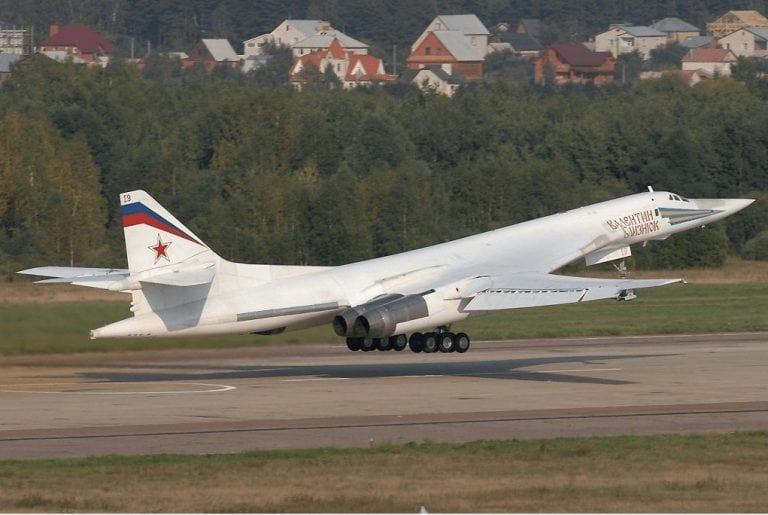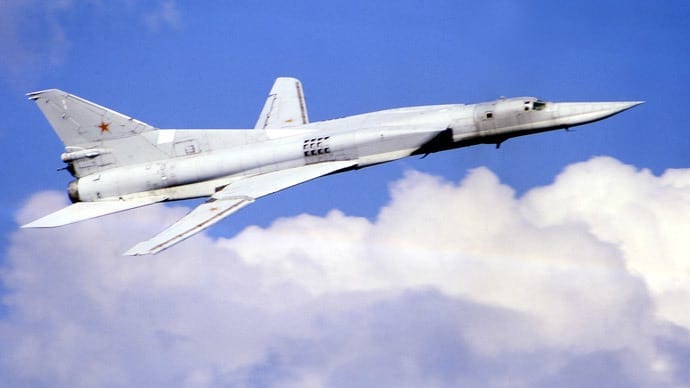Do We Really Want a New World War With Russia?
![]()
//
The US-instigated coup d’etat in Ukraine in February 2014, installed a cabal of gangsters, neo-nazis and criminals who launched a civil war against their own compatriots in east Ukraine.
Washington continues making an international fool of itself by its inability to effectively counter the impression around the world that Russia, spending less than 10% of the Pentagon annually on defense, has managed to do more against ISIS in Syria in six weeks than the mighty US Air Force bombing campaign has done in almost a year and half. One aspect that bears attention is the demonstration by the Russian military of new technologies that belie the widely-held Western notion that Russia is little more than a backward oil and raw material commodity exporter.
Recent reorganization of the Russian state military industrial complex as well as reorganization of the Soviet-era armed forces under Defense Minister Sergey Shoigu’s term are visible in the success so far of Russia’s ISIS and other terror strikes across Syria. Clearly Russian military capabilities have undergone a sea-change since the Soviet Cold War era.
In war there are never winners. Yet Russia has been in an unwanted de facto war with Washington since the George W. Bush Administration announced its lunatic plan to place what they euphemistically term “Ballistic Missile Defense” missiles and advanced radar in Poland, Czech Republic, Romania and Turkey after 2007. Without going into detail, BMD technologies are the opposite of defensive. They instead make a pre-emptive war highly likely. Of course the radioactive ash heap in such an exchange would be first and foremost the EU countries foolish enough to invite US BMD to their soil.
…
Then came the highly provocative US-instigated coup d’etat in Ukraine in February 2014, installing a cabal of gangsters, neo-nazis and criminals who launched a civil war against its own citizens in east Ukraine, an ill-conceived attempt to bring Russia into a ground war across her border. It followed two UN Security Council vetoes by Russia and China of US proposals for No Fly zones over Syria as was done to destroy Qaddafi’s Libya. Now Russia has surprised the West by accepting the request of Syrian President Bashar al Assad to help eliminate the terrorism that has ravaged the once-peaceful country for over four years.

The Syrian army has received advanced battlefield weapons from Russia, like this one, delivered in September.

Russia’s Defence Minister Sergey Shoygu is without a doubt one of the ablest administrators at the helm of a top military establishment. Fortunate for the world. And fortunate for Russia.
What the Russian General Staff has managed, since the precision air campaign began September 30, has stunned western defense planners with Russian technological feats not expected. Two specific technologies are worth looking at more closely: The Russian Sukoi SU-34 fighter-bomber and what is called the Bumblebee hyperbaric mortar weapon.
Sukhoi SU-34 ‘Fullback’ fighter-bomber

The plane responsible for some of the most damaging strikes on ISIS and other terror enclaves in Syria is manufactured by the Russian state aircraft industry under the name Sukhoi SU-34. As the Russian news agency RIA Novosti described the aircraft, “The Su-34 is meant to deliver a sufficiently large ordnance load to a predetermined area, hit the target accurately and take evasive action against pursuing enemy planes.” The plane is also designed to deal with enemy fighters in aerial combat such as the US F-16. The SU-34 made a first test flight in 1990 as the collapse of the Soviet Union and the chaos of the Yeltsin years caused many delays. Finally in 2010 the plane was in full production.
According to a report in US Defense Industry Daily, among the SU-34 features are:
• 8 ton ordnance load which can accommodate precision-guided weapons, as well as R-73/AA-11 Archer and R-77/AA-12 ‘AMRAAMSKI’ missiles and an internal 30mm GSh-301 gun.
• Maximum speed of Mach 1.8 at altitude.
• 3,000 km range, extensible to “over 4,000 km” with the help of additional drop tanks. The SU-34 can also refuel in mid-air.
• It can fly in TERCOM (Terrain Contour Matching) mode for low-level flight, and has software to execute a number of difficult maneuvers.
• Leninets B004 phased array multimode X-band radar, which interleaves terrain-following radar and other modes.
Now new EW technologies
[dropcap]C[/dropcap]learly the aircraft is impressive as it has demonstrated against terrorist centers in Syria. Now, however, beginning this month it will add a “game-changer” in the form of a new component. Speaking at the Dubai Air Show on November 12, Igor Nasenkov, the First Deputy General Director of the Radio-Electronic Technologies Concern (KRET) announced that this month, that is in the next few days, SUKHOI SU-34 fighter-bombers will become electronic warfare aircraft as well.
Nasenkov explained that the new Khibiny aircraft electronic countermeasures (ECM) systems, installed on the wingtips, will give the SU-34 jets electronic warfare capabilities to launch effective electronic countermeasures against radar systems, anti-aircraft missile systems and airborne early warning and control aircraft.

Truck-mounted Mobile Nuclear Strategic Forces’ missiles. One of the deterrents against too much American adventurism.
KRET is a holding or group of some 95 Russian state electronic companies formed in 2009 under the giant Russian state military industry holding, Rostec.
Russia’s advances in what is euphemistically termed in military jargon, Electronic Counter Measures or ECM, is causing some sleepless nights for the US Pentagon top brass to be sure. In the battles in eastern pro-Russian Ukraine earlier this year, as well as in the Black Sea, and now in Syria, according to ranking US military sources, Russia deployed highly-effective ECM technologies like the Krasukha-4, to successfully jam hostile radar and aircraft.
Lt. General Ben Hodges, Commander of US Army Europe (USAREUR) describes Russian ECM capabilities used in Ukraine as “eye-watering,” suggesting some US and NATO officers are more than slightly disturbed by what they see. Ronald Pontius, deputy to Army Cyber Command’s chief, Lt. Gen. Edward Cardon, told a conference in October that, “You can’t but come to the conclusion that we’re not making progress at the pace the threat demands.” In short, Pentagon planners have been caught flat-footed for all the trillions of wasted US taxpayer dollars in recent years thrown at the military industry.
[dropcap]D[/dropcap]uring the critical days of the March 2014 Crimean citizens’ referendum vote to appeal for status within Russia, New York Times reporters then in Crimea reported the presence of Russian electronic jamming systems, known as R-330Zh Zhitel, manufactured by Protek in Voronezh, Russia. That state-of-the-art technology was believed to have been used to prevent the Ukrainian Army from invading Crimea before the referendum. Russian forces in Crimea, where Russia had a legal basing agreement with Kiev, reportedly were able to block all communication of Kiev military forces, preventing a Crimean bloodbath. Washington was stunned.
…
USS Donald Cook…
[dropcap]T[/dropcap]hereafter, in April, 2014, one month after the accession of Crimea into the Russian Federation, President Obama ordered the USS Donald Cook into the Black Sea waters just off Crimea, the home port of Russia’s Black Sea Fleet, to “reassure” EU states of US resolve. Donald Cook was no ordinary guided missile destroyer. It had been refitted to be one of four ships as part of Washington’s Aegis Ballistic Missile Defense System aimed at Russia’s nuclear arsenal. USS Donald Cook boldly entered the Black Sea on April 8 heading to Russian territorial waters.
On April 12, just four days later, the US ship inexplicably left the area of the Crimean waters of the Black Sea for a port in NATO-member Romania. From there it left the Black Sea entirely. A report on April 30, 2014 in Russian newspaper Rossiyskaya Gazeta Online titled, “What Frightened the American Destroyer,” stated that while the USS Donald Cook was near Crimean (Russian by that time) waters, a Russian Su-24 Frontal Aviation bomber conducted a flyby of the destroyer.
The Rossiyskaya Gazeta went on to write that the Russian SU-24 “did not have bombs or missiles onboard. One canister with the Khibin electronic warfare complex was suspended under the fuselage.” As it got close to the US destroyer, the Khibins turned off the USS Donald Cook’s “radar, combat control circuits, and data transmission system – in short, they turned off the entire Aegis just like we turn off a television by pressing the button on the control panel. After this, the Su-24 simulated a missile launch at the blind and deaf ship. Later, it happened once again, and again – a total of 12 times.”
While the US Army denied the incident as Russian propaganda, the fact is that USS Donald Cook never approached Russian Black Sea waters again. Nor did NATO ships that replaced it in the Black Sea. A report in 2015 by the US Army’s Foreign Military Studies Office assessed that Russia, “does indeed possess a growing EW capability, and the political and military leadership understand the importance…Their growing ability to blind or disrupt digital communications might help level the playing field when fighting against a superior conventional foe.” Now new Russian Khibini Electronic Counter Measure systems are being installed on the wingtips of Russia’s SUKHOI SU-34 fighter-bombers going after ISIS in Syria.
Killer Bumblebees
[dropcap]A[/dropcap] second highly-advanced new Russian military technology that’s raising more than eyebrows in US Defense Secretary ‘Ash’ Carter’s Pentagon is Russia’s new Bumblebee which Russia’s military classifies as a flamethrower. In reality it is a highly advanced thermobaric weapon which launches a warhead that uses a combination of an explosive charge and highly combustible fuel. When the rocket reaches the target, the fuel is dispersed in a cloud that is then detonated by the explosive charge. US Military experts recently asked by the US scientific and engineering magazine Popular Mechanics to evaluate the Bumblebee stated that, “the resulting explosion is devastating, radiating a shockwave and fireball up to six or seven meters in diameter.” The US experts noted that the Bumblebee is “especially useful against troops in bunkers, trenches, and even armored vehicles, as the dispersing gas can enter small spaces and allow the fireball to expand inside. Thermobarics are particularly devastating to buildings — a thermobaric round entering a structure can literally blow up the building from within with overpressure.”
‘Status-6′
We don’t go into yet another new highly secret Russian military technology recently subject of a Russian TV report beyond a brief mention, as little is known. It is indicative of what is being developed as Russia prepares for the unthinkable from Washington. The “Ocean Multipurpose System: Status-6” is a new Russian nuclear submarine weapons system designed to bypass NATO radars and any existing missile defense systems, while causing heavy damage to “important economic facilities” along the enemy’s coastal regions.
Reportedly the Status-6 will cause what the Russian military terms, “assured unacceptable damage” to an adversary force. They state that its detonation “in the area of the enemy coast” (say, New York or Boston or Washington?) would result in “extensive zones of radioactive contamination” that would ensure that the region would not be used for “military, economic, business or other activity for a long time.” Status-6 reportedly is a massive torpedo, designated as a “self-propelled underwater vehicle.” It has a range of up to 10 thousand kilometers and can operate at a depth of up to 1,000 meters. At a November 10 meeting with the Russian military chiefs, Vladimir Putin stated that Russia would counter NATO’s US-led missile shield program through “new strike systems capable of penetrating any missile defenses.” Presumably he was referring to Status-6.
US Defense Secretary Carter declared on November 8 in a speech that Russia and China are challenging “American pre-eminence” and Washington’s so-called “stewardship of the world order.” Carter added that, “Most disturbing is Moscow’s nuclear saber-rattling,” which in his view, “raises questions about Russian leaders’ commitment to strategic stability, their respect for norms against the use of nuclear weapons…” [The Orwellian hypocrisy in this statement alone is colossal.—Eds.]
Not surprisingly, Carter did not mention Washington’s own very loud nuclear saber-rattling. In addition to advancing the US Ballistic Missile Defense array targeting Russia, Carter recently announced highly-advanced US nuclear weapons would be stationed at the Büchel Air Base in Germany as part of a joint NATO nuclear program, which involves non-nuclear NATO states in Europe hosting more than 200 US nuclear warheads. Those NATO states across Europe, including Germany, have just become a potential Ground Zero in any possible nuclear war between the United States and Russia. Perhaps it’s time for some more sober minds to take responsibility in Washington for restoring a world at peace, minds not obsessed with such ridiculous ideas of “pre-eminence.”
 F. William Engdahl is strategic risk consultant and lecturer, he holds a degree in politics from Princeton University and is a best-selling author on oil and geopolitics. This is a crosspost with Journal NEO.
F. William Engdahl is strategic risk consultant and lecturer, he holds a degree in politics from Princeton University and is a best-selling author on oil and geopolitics. This is a crosspost with Journal NEO.
Note to Commenters
Due to severe hacking attacks in the recent past that brought our site down for up to 11 days with considerable loss of circulation, we exercise extreme caution in the comments we publish, as the comment box has been one of the main arteries to inject malicious code. Because of that comments may not appear immediately, but rest assured that if you are a legitimate commenter your opinion will be published within 24 hours. If your comment fails to appear, and you wish to reach us directly, send us a mail at: editor@greanvillepost.com
We apologize for this inconvenience.
![]() Nauseated by the
Nauseated by the
vile corporate media?
Had enough of their lies, escapism,
omissions and relentless manipulation?
Send a donation to
The Greanville Post–or
But be sure to support YOUR media.
If you don’t, who will?









